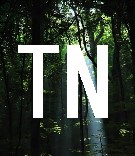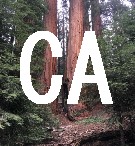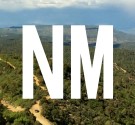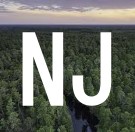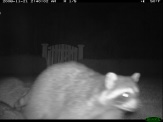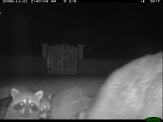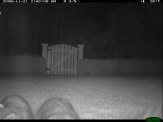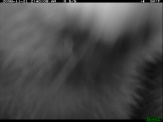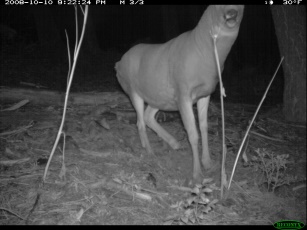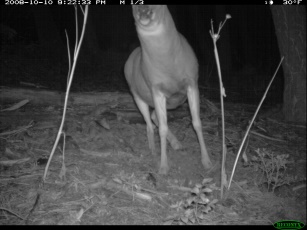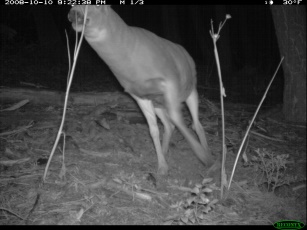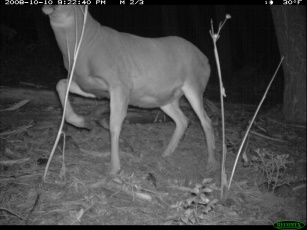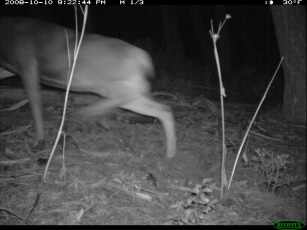|
|

|
Wally Hersom will Provide Reconyx Trail Cameras to Rangers
| |
UPDATE: December 1, 2008 -- First winning
proposal from a ranger.
Wally Hersom (BFRO sponsor) obtained the photo shown below on his back
porch in Southern California on November 11, 2008, in the course of testing
a relatively new type of motion sensing trail camera -- the stealthy,
silent, fast-trigger, rapid-fire trail camera called the Reconyx-RC60-HO.
Wally is so encouraged by this new trail camera that he is buying several
more of them.
Wally has already been circulating Reconyx units among BFRO members (the
same type of trail cam but without the high-output "HO" upgrade).
Along with BFRO members, Wally wants to put these new trail cameras into
the hands of any park rangers in the US or Canada (including rangers in
tribal jurisdictions) who may know of good places to obtain photos of
bigfoots. See the information near the bottom of this page about this
free equipment program for rangers.
Wally is recommending that all other bigfoot researchers buy these units
as well, if they are going to buy a trail camera at all. These Reconyx
trail cams cost three times as much as the typical trail camera at Walmart,
but they are much, much more likely to get photos of elusive animals.
It is very difficult to obtain a photo like this one below with an inexpensive
Walmart trail camera -- a clear, centered photo of an elusive, stealthy
and alert North American bobcat (Felis rufus).
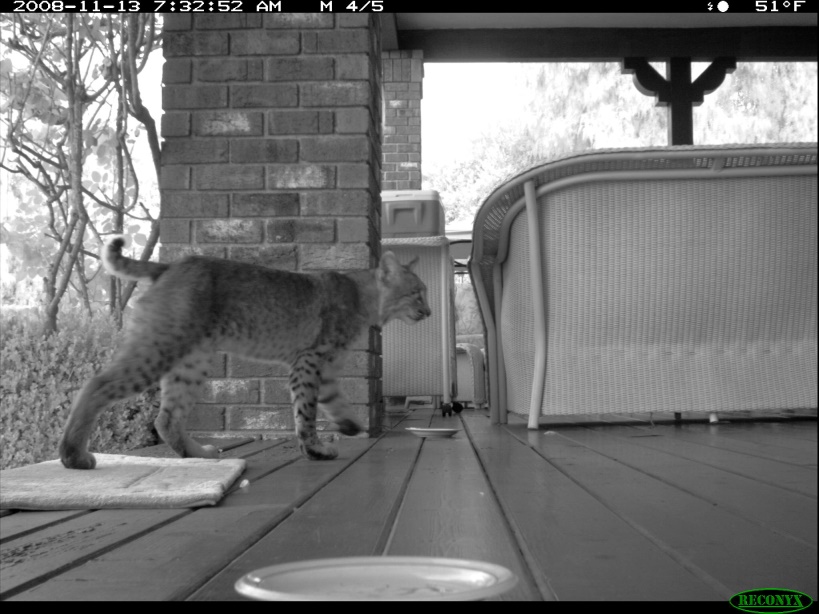
Wally has tested the most common types of trail cameras over the past
18 months, to see which type would be best for obtaining photos of bigfoots.
At this point he is uniquely familiar with the shared traits of the common
trail cameras -- the ones in widest circulation among the general public
(in the U.S. and Canada).
Professional skeptics often say that the proliferation of trail cameras
among Americans and Canadian should have resulted in many good photos
of bigfoots by now. It sounds logical to them, but Wally emphatically
disagrees. He says no one should be surprised that there are only a few
photos from trail cameras that likely show a bigfoot (such as the Jacobs
Photos) given the limitations of all the common trail cameras.
This raccoon sequence from Wally Hersom's backyard helps further illustrate
the distinctions between the Reconyx RC60 and a common (Walmart) trail camera.
When the Reconyx obtained these photos, there was a common trail camera
(the specific brand shall go unnamed) approximately five feet away from
it, and aimed toward the same place where these raccoons are seen walking
across.
These raccoons walked right in front of that Walmart trail camera, therefore
it should have gotten at least one decent photo of these same raccoons,
but it missed it. It got nothing! The Walmart trail cam was working properly,
and had a fresh set of batteries, but it also had the combination of limitations
present in almost every inexpensive trail camera, enabling the raccoons
to pass by without being photographed.
Experiences like these repeatedly demonstrate how common trail cameras in
the past may have easily missed many opportunities for photos of a passing
bigfoot. On the positive side, these same experiences also demonstrate that
the new technology may obtain some astounding images that were missed in
the past. |
| |
|
Reconyx
RC60 Shots of a Passing Buck.
If only this were a bigfoot...
(Click images for full versions)
|
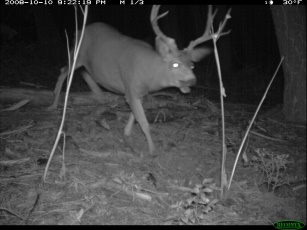 |
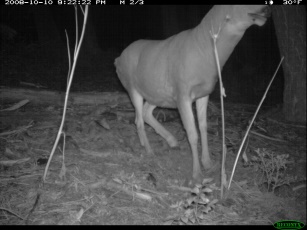 |
|
|
|
|
|
|
|
|
|
|
This deer hung around for much longer than
it appears from the strip above. Notice the time stamps on the large
versions of the images. Twenty-five seconds passed between the first
photo and the last photo. The strip above does not show all the
images in the sequence.
These images were obtained in Montana with one of Wally's Reconyx
RC60 units on loan to deer hunter Derek Randles (WA-BFRO) |
|
Most trail cameras could not have obtained
this sequence of images, because most trail cams can only shoot
one photo every 30-60 seconds.
This sequence is another example of a strange (and potentially
useful) behavior first noticed by Wally Hersom. He noticed how
the Reconyx RC60 (which has a totally invisible filtered IR illuminator)
causes deer to pause, and look, and sniff, and move closer to
the camera as if to inspect it.
The underlying mystery is how the deer can detect the camera in
the first place, if they cannot hear it, see it, smell it, or
feel it. They must be either hearing, or seeing, or smelling,
or feeling something, but exactly what it senses is still unclear.
Scientifically speaking, deer should not be able to see the illuminator
at all, because deer eyes are even less sensitive to infrared
than human eyes. Deer eyes are much more sensitive than ours in
the UV range (where it counts for moonlight, twilight and starlight)
but not in the IR range.
Smell is probably not the stimuli involved because the same behavior
will occur when the trail camera is set downwind from the deer
trail.
The answer may be, or may not be, ultrasound (i.e. sound that
is too high pitched for humans to hear). Although sensitive instruments
can detect some degree of ultrasound coming from many types of
electronic equipment, it does not automatically follow that other
mammals can hear it. Ultrasound means any beyond the human range.
Futhermore, there are good reasons to believe that ultrasound
is not the factor that catches the attention of deer. 1) The deer
have to approach within 20 feet of the camera in order to "hear"
this sound at all -- a high pitched tone which should be slightly
audible to deer 40 feet away if it can be heard so distinctly
at 20 feet away. 2) This bobcat, for example, did not notice seem
to notice any ultrasound, even though it can probably hear some
ultrasound, and it was only 3-4 feet away from the camera.
Another possibility: The invisible IR illuminator beams out just
enough warm IR light for the deer to feel it 20 feet away
or so, but not much beyond that. A warmth sensation would drop
off much more sharply than a high-pitched tone as one moves away
from the camera.
The beamed warmth alternative would explain why we've only seen
this mezmerising effect in cold temperatures.
In the bobcat photos, the sun was shining and the temperature
was 51 degrees -- possibly too much ambient warmth for the bobcat
to detect a very slight subtle heat sensation from the illuminator.
A slight, subtle heat sensation would be much more when the ambient
temperature is closer to the freezing point.
In the sequence of deer shots above, the ambient temperature was
30 degrees F., as seen in the margin data of the large versions
of the images.
Yet another possibility is that animals sometimes notice the moonlight/starlight
reflected off the glassy lens covers. We considered this possibility
some time ago. It was suggested again recently by someone else
who is testing the Reconyx RC60. He thinks the deer see the lens
reflection at night in the woods, at they instinctually interpret
it as reflection from a big eye looking at them. This possibility
would explain why the deer hold still for a moment, then crane
their necks a bit, then freeze again, as they notice that the
reflection seems to move as they move their heads.
The bobcat would have paid no attention to this lens cover reflection
on Wally's back porch because there's whole wall of reflective
glass along the porch, in the form of full-length French doors.
In that context a lens reflection from a Reconyx would not be
unusual, but the lens reflection would be very eye-catching in
the woods at night, where the only things that reflect light this
way are the surfaces of puddles, and big eyeballs.
|
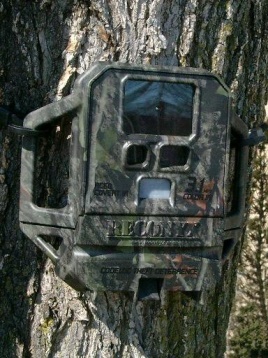 The Reconyx RC60
The Reconyx RC60 |
The Reconyx-RC60 appears to have resolved the major design limitations
which are present in all other trail cameras:
1) Trigger response delays >> 2-3 seconds for the cheapest
models.
This is the delay between the point when the camera senses movement,
and when it actually snaps the image. The Reconyx RC60 has the shortest
delay we've ever seen -- approximaly one fifth of second, depending
upon the ambient temperature.
2) Only one photo every 30-60 seconds, maximum, for common trail
cameras.
In contrast to the Reconyx RC60 which will shoot one photo per
second (or one photo every few seconds if the ambient temperature
is below the freezing point), as long as it is detecting movement.
3) The motion-sensor's field of view is too narrow.
In common trail cams the movement must be in the middle of the field
of view before the camera senses it. The Reconyx RC60 motion-sensor's
field of view, by contrast, is wider than the whole image, so it senses
animal movement even before the animal is fully in the picture. That's
not a problem because it will snap another photo roughly one second
later when the animal is more in view, compared to a whole minute later
for common trail cameras.
4) Very visible illuminators that will tend to frighten the most
skittish creatures at night.
Even "invisible flash" IR illuminators are very visible. --
The Reconyx RC60 is the only type that is truly invisible to
the human eye, and quite possibly invisible to the bigfoot eye as well.
If not completely invisible to the bigfoot eye, it is certainly much
less visible than any other type of trail camera.
5) The limited range of common trail cam IR illuminators.
30 feet max., compare that to 75 feet max. for the Reconyx-RC60-HO.
This unfortunate combination of limitations in common trail cameras
means that passing bigfoots will not even be sensed until they are more
or less in the center of the field of view -- an appropriate feature
for a camera that can only take one photo per minute -- but that means
animals passing laterally through the field of view are less likely
to be photographed, because they will already be half way across the
field of view before the camera even begins to "wake up" to
snap the image. This limitation combined with a trigger delay of a couple
of seconds, means the passing animal will be out of the camera's' field
of view before it snaps the image most of the time.
The images snapped in those cases will appear to be false triggers.
They will be empty -- nothing in the photo except the background. Mysteriously
empty photos like these are usually the norm with most trail cameras,
because most passing animals do not stop and hang around right in front
of a trail camera unless they are lured to do so by bait.
Animals like bears and deer get photographed by common trail cameras
most often when they have come to a complete stop, attracted
into the field of view by scent baits, salt licks, etc. Photos of bear,
deer, etc., can also happen when the animals are walking slowly, or
they are moving away or toward the camera at an angle (thus giving the
camera more time to snap the image).
Bigfoots are typically not drawn to the same types of bait as deer and
bears. The Jacobs Photo was apparently a big exception. The young bigfoot
in that sequence stopped to smell the aromatic deer attractant that
had been sprinkled on the ground by the Jacobs Brothers. We know this
because the creature's face and nose was pressed to ground where the
attractant scent was dispersed on the ground.
Hypothetically, if a bigfoot were to pass by a common IR trail camera
after dark (which is when bigfoots are most active), and not slow down,
the trail camera would not get the picture in time ... but the
passing bigfoot would notice the glowing IR LED in its peripheral vision.
All common trail camera IR LED illuminators are very noticeable
to the naked eye in dark conditions. Those illuminators look like a
small red tail-light on a vehicle (though much dimmer), when they flash
at night.
We know these illuminators will still be visible in a bigfoot's peripheral
vision just after it passes out of the camera's field of view, because
those illuminators are visible in our own peripheral vision after we
have passed out of the cameras field of view.
The Reconyx RC60 has an excellent and simple fix for this problem. It
uses a special light filter over the face of the IR LED panel. The filter
blocks all the visible wavelengths coming from the IR LEDs, but allows
the truly invisible, lower frequency IR wavelengths to pass through.
Hence, this type of filter is known as a "low-pass IR filter."
The underlying IR LED panel on the Reconyx RC60 is actually the same
type of IR LED panel used by the common IR trail cameras ... The only
difference is the filter on the Reconyx. But the filter is a not a typical
low-pass IR filter. We looked around to find sheets of this filter plastic,
hoping to retrofit some other trail cameras with it. None of the other
plastic low-pass IR filters we tested could completely block all the
visible (red) light like the filters on the Reconyx RC60.
Wally even put a Reconyx RC60 filter over the IR LED panels of some
common (Walmart) trail cams to see what would happen. It made those
IR illuminators totally invisible.
We suspect the Reconyx filter is a custom chemical formulation made
exclusively for the Reconyx company.
It would be a profitable idea for a company like Bushnell to find a
similar plastic formulation, and then offer "filter retrofit kits"
for their currrent and previous IR trail cam models. These retrofit
kits would be very helpful, because Bushnell trail cameras cost a fraction
of the Reconyx -- only $150 compared to $650 for a Reconyx -- which
means you could buy four Bushnell trail cameras for the price of one
Reconyx.
A filter retrofit kit merely needs to contain a palm-size rectangle
of plastic, pre-cut to the right shape for the particular model of trail
cam, so it can snap into place or be held in place with electrician's
tape over the existing IR LED panel. So the full kit consists of a piece
of plastic + a piece of paper saying how to attach the piece of plastic.
A filter retrofit kit would not make a trail camera any faster, in
terms of trigger delay ... or give it the rapid-fire ability of the
Reconyx ... but at least it would give Bushnell trail cameras, etc.,
more than a single opportunity, at a given spot, to get a prize image
of a bigfoot.
An unfiltered IR LED panel will cause a jolt of fear in an animal with
sensitive night eyes, especially one walking within a few yards of it.
It will cause a jolt of fear as surely as a small horn.
For all those reasons the common (Walmart) trail cameras are mostly
ineffective as bigfoot image gathering devices, but they are likely
very effective as bigfoot scaring and detering devices.
As mentioned above, Wally would like to get these exciting new Reconyx
units into the hands of park rangers who are aware of bigfoot activity
in their forests.
If you are a ranger, or something similar, and you know of a place (a
spring, a pond, a cave, a trail, a dirt road, etc.) that is very likely
visited by bigfoots, then you should request a Reconyx from Wally and
set it up at that spot.
These cameras will be on indefinite loan to the rangers personally.
The photos obtained will legally belong to those rangers, but Wally
expects to receive courtesy copies of any good animal images obtained
with his cameras. This courtesy is not too much to ask, and is not difficult
because digital photos are easy to attach to emails.
The ranger's own project should be unofficial, and basically under the
radar, and not on government time, and thus not on the public's dime.
There should be no conflict with a ranger's superiors, because there
would be no conflict if that ranger were to take photos of birds when
he/she's off the clock.
If it would be totally legal for some other person to set up a trail
cam in the given forest, then it would also be totally legal for a ranger
to do the same, when he/she's off the clock.
A set of fully charged batteries will keep the unit powered and taking
photos for about a month. The compact flash memory card we will supply
will hold more than 5,000 high resolution images each -- more images
than the camera will obtain in a month. We'll throw in a second high
capacity memory card so it can be quickly swapped in the field whenever
the batteries are swapped. We will also include a memory card reader.
There will be two full sets of special rechargeable batteries and a
charger, so you won't have to spend any money at all. You will have
everything you need to get lots of photos, in total darkness, with a
very stealthy rapid-fire camera.
The ranger never needs to reveal target location where the camera will
be set up. A ranger certainly may reveal the location, but any details
will not be released publicly without his/her explicit approval. That's
our policy.
Legitimate rangers should contact Wally directly at Wally@BFRO.net
The Scientific Importance
of these Experiments
In the history of science there have been at least two major leaps
of scientific advancement that were directly traceable to the introduction
and dispersion of new optical devices. These devices allowed science-minded
people to peer into worlds previously unseen by humans, which ushered
in various revolutionary discoveries.
The introduction and dispersion of the telescope in the early
seventeenth century allowed science-minded people to better observe
celestial objects, which gradually led to a huge leap in our understanding
of the universe, and the origin of our own planet, and life itself.
Likewise, the introducton and dispersion of the microscope in
the late seventeeth century gradually led to a huge leap in understanding
of the micro-world, including the bio-cellular world.
Being able to peer into the bio-cellular world led to a revolutionary
new understanding of our own bodies, and the many previously-unseen
micro entities that continually try to feed on our bodies.
Modern medicine owes as much, if not more, to the microscope than it
does to modern chemistry.
In the early twenty-first century we are witnessing the introduction
and dispersion of several different types of optical/imaging devices
that will allow us to peer into new worlds that were previously unseen,
for the most part. Thermal imagers, nightvision scopes, and IR trail
cameras allow us to see the natural world in the dark, where many things
happen that do not occur when natural light or (visible) artificial
light is present, or when humans are present.
The very wide dispersion of inexpensive digitial cameras and camcorders,
in combination with image sharing mechanisms like YouTube, is already
showing humanity views of the world and humanity that we have never
before seen.
We can expect to see some unexpected things in the next few years, as
more people peer into new worlds, and capture those views in digital
form, and distribute those digital files across the Internet.
Thermal imagers and nightvision scopes will each see into different
worlds, in a sense, but their relatively high cost will make them less
of a force of discovery than devices such as motion-sensing IR trail
cameras, which cost ten times less, and therefore will be experimented
with by a much larger number of science-minded people.
IR trail cameras have other inherent advantages. They are designed to
work by themselves, and they stand ready to capture images 24/7 for
weeks at a time without any tending, although almost all trail cameras
in circulation at this time are, in reality, not very good at capturing
images of passing animals. They do not get these images as reliably
as one would expect. The Reconyx RC60 is huge leap forward, in terms
of capturing images of passing animals, as reliably as one would expect.
|
| |
Military/Security
Applications of Trail Cameras
The CIA and FBI are said to use cleverly concealed, custom-built,
motion-sensing cameras for special investigatons and special missions.
Regular troops and regular law enforcement officers would not be using
those devices widely, because there would not be enough of them to go
around.
As the militaries of Canada and America gain greater and greater appreciation
for the many benefits of unmanned aerial vehicles, other unmanned technologies,
like off-the-shelf trail cams, will naturally receive more consideration.
More soldiers and law enforcers will surely experiment with devices
like the Reconyx RC60, as they begin to witness thier effectiveness
for monitoring roads and trails reliably, unlike most other trail
cams in circulation.
Trail cams (reliable trail cams) will be increasingly appreciated
as highly portable unmanned stakeout and reconnaissance tools, because
individual soldiers/police can deploy several of them quickly, and thereby
cover more pathways reliably, without having to remain awake and vigilent
through the night.
Certain features need to be incorportated into the Reconyx RC60 before
it will be optimally useful in every context.
If the intended subjects are humans rather than animals, then two separate
wireless features will make this trail cam much more effective.
The user should be able to connect to the trail cam via a laptop to
download images from it, but the user needs to be able to do this wirelessly,
from up to 100 feet away, and even from inside a vehicle up to 100 feet
away.
Why?
In natural settings trail cams that are set to take photos of human
activity (instead of animal activity) must be very well concealed and/or
camouflaged, for obvious reasons. But excellent concealment and/or camouflage
of a trail camera slows down the process of image retrieval later on,
especially if a trail cam is high up in a tree, or on a steep slope,
or among delicate foliage that helps conceal/camouflage the device.
WiFi connectivity would eliminate most of the physical complications
and risks, and would dramatically speed up the overall process of image
retrieval, especially when there are many trail cams to check.
Although many wireless devices can be detected with small WiFi detectors,
a trail camera's WiFi ability could be made undetectable, because the
WiFi component would not need to be active all the time. The WiFi component
could be triggered to wake up from hibernation via a radio signal. Only
then would the tram cam's WiFi system become detectable and connectable
via a Blue Tooth enabled laptop.
In a Utopian world for trail cam users, the user would merely needs
to drive within 100 feet or so of the trail cam to connect to
it and download images onto a laptop, without even getting out of the
car. If a trail cam can do that, then a single user could systematically
drive around and download images from dozens of trail cams in a single
day, yielding a reliable record of all the vehicle traffic and foot
traffic on the targetted pathways.
Trail cams only need be opened up once every two months
in order to swap out batteries. Even that process can be greatly simplified,
if the trail cam has an external power port. A few different trail cam
models do have an ext power port -- sadly, however, not the Reconxy.
An external power port on a trail camera allows for an external battery
pack (holding six C or D cells) to be burried in the ground at the base
of a tree, then a thin power cable from the external battery pack inconspicuously
climbs up the tree trunk to power a trail cam that is well above easy
reach.
With those two features -- WiFi and external power -- a trail cam set
high up in a tree would not need to be touched at all after installation.
Some very high end wildlife monitoring systems are even more hands-off.
They have either a cell phone connection, or a satellite phone connection,
or a microwave dish transmitter. They also have a solar panel to keep
the whole system charged indefinitely and transmitting images. But these
systems cost several thousand dollars, and they are not small.
Solar panels would complicate the concealment/camouflage of small trail
cams aimed at human activity. Solar panels would also limit the number
of places where trail cams could be set up, because they would need
direct sunlight most of the day.
The other helpful wireless feature would be a detachable wireless
motion sensor, which would trigger (via a wireless signal) the trail
cam to take shots from a distance.
In this configuraton the IR LED panel should be detachable as well,
so it can be set closer to the motion sensor. The trail camera would
need to transmit a trigger signal to the illuminator(s), to make them
flash at the right instance.
Telephoto ability means better concealment. If the trail cam
has a telephoto setting (as good as the telephoto ability on the average
digital camera), then it could be set so far back off the road that
it would be very, very unnoticeable to passing human traffic.
|
| |
|
| |
|
|





